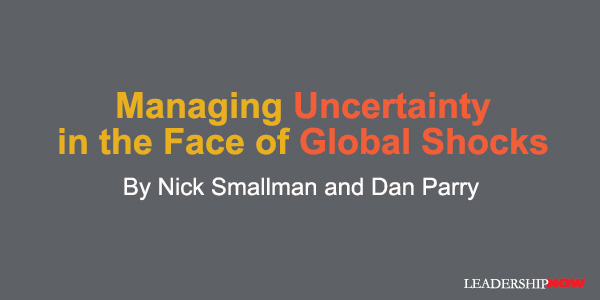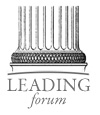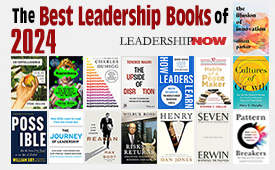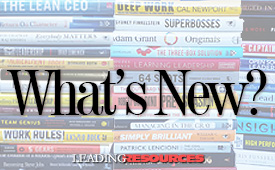 |
 |
04.25.25

Managing Uncertainty in the Face of Global Shocks
UNCERTAINTY is dominating business planning. The tariffs announced on April 2 could trigger “a self-induced, economic nuclear winter,” according to hedge fund manager Bill Ackman. Businesses and nations are locked into a complex, international web of trade networks, just-in-time supply systems, currency exchanges, and mutual competition. And much of it is underpinned by the US dollar. Far from the US being “forced to sit on the sidelines as other nations got rich and powerful,” US GDP per capita is much higher than that of any other large country. Consequently, global shocks — perhaps arising from unilateral decisions on international trade, climate change, or a pandemic — can trigger a negative impact that touches businesses everywhere. In the US, tariffs will make foreign cars more costly for consumers. But US-built cars contain many foreign parts that are now set to become more expensive. And US car makers are likely to take the opportunity to raise their prices too. Higher prices on Main Street are unlikely to come without pain. Reacting to falling consumer confidence — down 30 percent since November 2024 — Federal Reserve Chair Jerome Powell was warning of “heightened uncertainty” even before the April 2 tariffs. Since then, volatility in the markets has increased the risk of difficult trading conditions in the next year at least. Fearful moments like this can lead either to paralysis that delays decisions and freezes actions or to panicky impulses to do something. A third way, however, helps leaders find a more reliable path back to stability. Fearful reactions are natural. But they can affect your judgement and stop you thinking rationally. You can’t prevent an emotional response to uncertainty, but you can keep it in context. Smart leaders prepare in advance, protecting business continuity by developing resilience in their business and their people. This safety net gives them the confidence to sidestep unhelpful emotions so that they can focus on the decisions that will help to make a difference. Here’s how: 1. Reset your relationship with uncertainty Imagine taking a daily walk in the park. Change involves taking an unfamiliar path. Complexity comes when the new path breaks into multiple different paths. Uncertainty switches off daylight and introduces a cliff edge while you try to get home safely. The brain likes to see things clearly and confidently. Without certainty we feel fearful, which leads to two further reactions. We might either pause decisions and actions, and tread carefully to avoid stumbling off the cliff into the worst effects of a recession. Or we might try the opposite and rush to act, so that we’re doing something — anything — whether it might help in the long-run or not. By recognizing fear as a first response rather than a final one, you can get past these fight-or-flight reactions and find the peace of mind to calmly and effectively stick to your plan. 2. Work with your people When certainty is thin on the ground, leaders can’t be expected to have all the answers. It helps to have the support of other people. This is organizational resilience, which relies on personal character. Leaders can help their people find the confidence and creativity to cope in a crisis by encouraging a culture of social wellbeing. Focusing on trust, respect, belonging, and psychological safety, social wellbeing brings people together, giving them the reassurance to suggest new solutions, try new things, and collaborate in effective teamwork. For example, collective intelligence rises when teamwork is stronger, dissenting opinions are allowed, and no one defaults to blame. In times of difficulty, relationships between employers and employees can be cemented by clear-cut communication. Regular updates and honest assessments help lay the groundwork for tough messaging that may need to be delivered. It also helps to talk to people outside the team, even outside the business. Leaders who turn to their personal network may find new ideas and alternatives that may shape their decisions. 3. Get back to making decisions Having freed themselves from emotions and assessed information and options from both inside and outside the business, leaders can make the informed decisions that will start to restore a little stability. A decision-making framework is helpful, especially when practiced over time. This can rely on one of the forms of critical thinking. For example, scientific thinking approaches things from the mindset of a scientist — making an assumption, looking for evidence, and using it to assess whether the assumption is correct. Scientific thinking helps to nail down certainty. Similarly, flexible thinking (toggling between alternate viewpoints, known as “mental models”), or creative thinking (suspending conformity and workshopping new solutions), can also support decision-making processes. Abilities in managing uncertainty — breaking free of emotions, encouraging a healthy culture, building resilience, setting communication standards, and effective decision-making — are collectively known as future skills. Together they offer decisive steps in coping with the fallout of uncertainty. Future skills are best developed in advance. They can be learned through training, and they bring out the best in human capabilities. In the uncertain months ahead, whether America slides into recession or not, well-prepared organizations will lead the way back to better days. Leaders who have the resilience, the preparation, and the team to get back on track will be able to reclaim a little competitive edge and help their organization make the all-important shift from surviving to thriving.  
Posted by Michael McKinney at 10:17 AM
|
BUILD YOUR KNOWLEDGE
 

How to Do Your Start-Up Right STRAIGHT TALK FOR START-UPS 
Grow Your Leadership Skills NEW AND UPCOMING LEADERSHIP BOOKS 
Leadership Minute BITE-SIZE CONCEPTS YOU CAN CHEW ON 
Classic Leadership Books BOOKS TO READ BEFORE YOU LEAD |